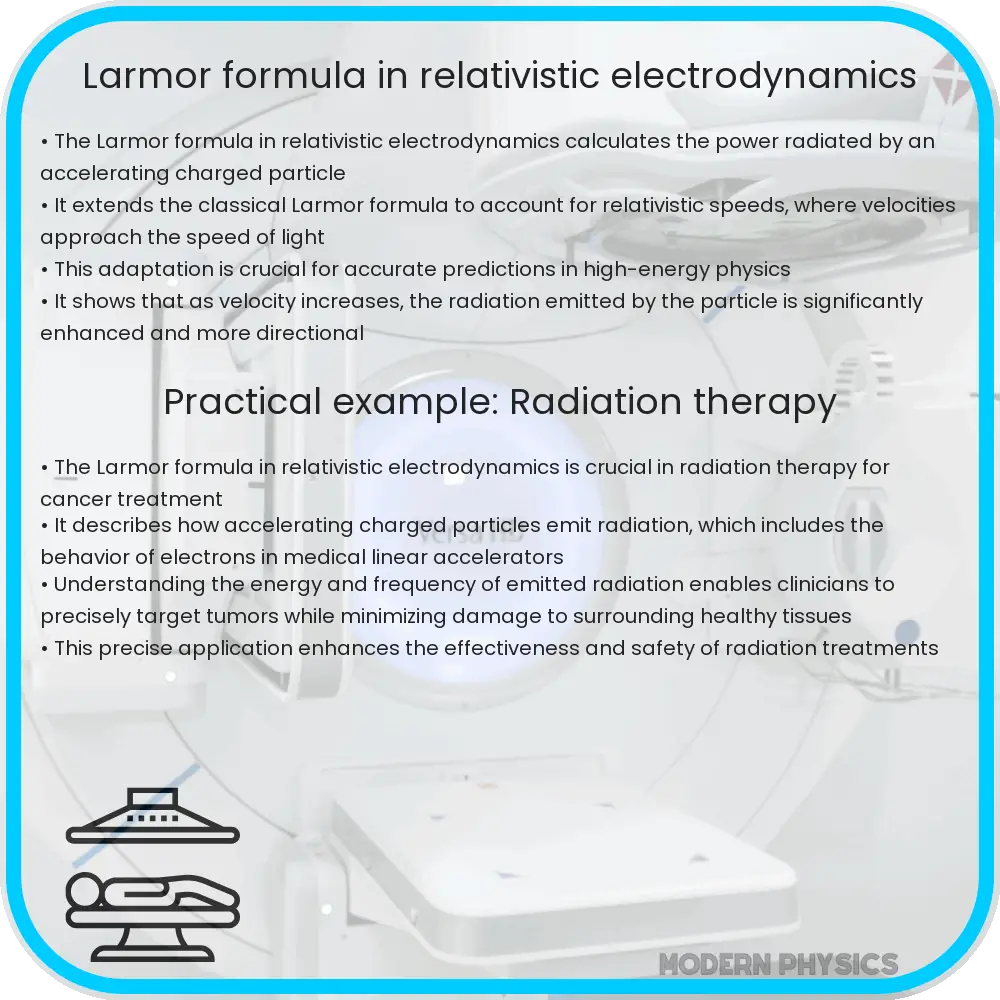Larmor formula explains power radiated by accelerating charged particles, crucial for understanding energy loss and radiation in both classical and relativistic frameworks.

Larmor Formula | Relativistic Dynamics, Energy Loss & Radiation
The Larmor formula is a fundamental expression in electrodynamics that describes the power radiated by a charged particle when it accelerates. This is particularly important in understanding phenomena in both classical and relativistic physics. Let’s delve into the principles behind the Larmor formula, explore its derivation, and examine its role in relativistic dynamics, energy loss, and radiation.
The Larmor Formula
The classical Larmor formula gives the power \( P \) radiated by a non-relativistic point charge q moving with acceleration a:
\[
P = \frac{q^2 a^2}{6 \pi \epsilon_0 c^3}
\]
Here, ε0 is the permittivity of free space, and c is the speed of light in a vacuum. This formula is derived from Maxwell’s equations and assumes that the velocity of the particle is much less than the speed of light (v << c).
Relativistic Generalization
When dealing with particles moving at speeds comparable to the speed of light, relativistic effects become significant. The relativistic generalization of the Larmor formula takes into account the factor by which time is dilated due to the high velocity. The power emitted by a relativistic charged particle is given by:
\[
P = \frac{q^2 a^2 \gamma^6}{6 \pi \epsilon_0 c^3}\left(1 – \frac{v^2}{c^2}\right)
\]
In this equation, γ (gamma) is the Lorentz factor, defined as:
\[
\gamma = \frac{1}{\sqrt{1 – \frac{v^2}{c^2}}}
\]
This equation indicates that as the velocity approaches the speed of light (v → c), the radiation power increases dramatically.
Energy Loss
In accelerators and astrophysical contexts, energy loss due to radiation is a critical consideration. The energy loss occurs because the charged particle emits electromagnetic waves when it accelerates, carrying away energy. This loss of energy due to radiation is often referred to as “radiative energy loss” or “synchrotron radiation” in the context of circular accelerators.
The energy loss per revolution for a particle moving in a circular path is often used in designing particle accelerators and can be approximated for ultra-relativistic speeds (when v is very close to c). The total energy loss can significantly affect the stability and confinement of the particles.
Applications in Real-World Physics
The Larmor formula and its relativistic extensions are crucial in several areas of physics:
- Synchrotron Radiation: In circular accelerators like synchrotrons, charged particles moving at relativistic speeds emit significant amounts of radiation. This is a primary mechanism by which high-energy particles lose energy.
- Astronomy: The study of various astrophysical objects, such as pulsars and black holes, also relies on understanding radiation from highly accelerated charges.
- Medical Physics: Advanced imaging techniques, including certain types of radiation therapy, depend on principles derived from the Larmor formula.
Practical Examples
Understanding the Larmor formula’s application can be enhanced with a few real-world examples. Here are some practical scenarios where the formula plays a significant role:
- Cyclotrons and Synchrotrons: Particle accelerators such as cyclotrons and synchrotrons accelerate charged particles to very high speeds. The Larmor formula helps in estimating the energy loss due to synchrotron radiation, which is crucial in designing efficient and effective particle accelerators.
- Radio Transmitters: Accelerating charges in antennas produce electromagnetic waves which are radiated as radio signals. The Larmor formula helps engineers understand the power radiated as a function of the currents and voltages applied to the antennas.
- Astrophysical Phenomena: High-energy astrophysical events such as solar flares, pulsar emissions, and black hole jets involve massive amounts of charged particles accelerating at relativistic speeds, leading to significant radiation based on the principles encapsulated by the Larmor formula.
Impulse Radiation
Impulse radiation refers to the emission of radiation when a charged particle experiences a sudden acceleration, such as a sudden jerk or change in trajectory. This is a special case of the Larmor formula where the nature of the energy loss can be rapid and localized:
- Cosmic Rays: High-energy particles traveling through space can encounter abrupt changes in velocity when interacting with interstellar magnetic fields, leading to bursts of radiation.
- Particle Induced X-ray Emission (PIXE): In laboratory settings, when high-energy charged particles impact a material, they can cause sudden accelerations in the material’s atoms, resulting in impulse radiation, which is detectable and analyzable.
Conclusion
The Larmor formula is an essential tool in the field of electrodynamics for calculating the power radiated by accelerating charged particles. Its applicability spans a range of speeds from non-relativistic to relativistic, making it a versatile principle in both classical and modern physics. Understanding the energy loss mechanisms due to radiation is key in fields such as particle physics, astronomy, and even medical applications. By studying and applying the Larmor formula, scientists and engineers gain critical insights into the behavior of charged particles and the energy dynamics of various electromagnetic phenomena.
